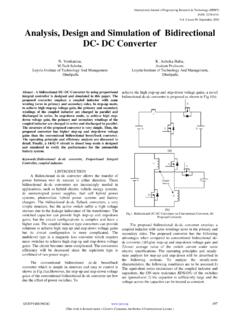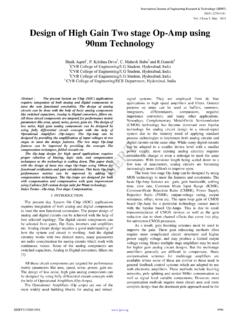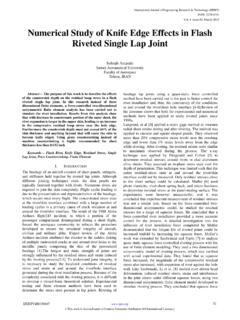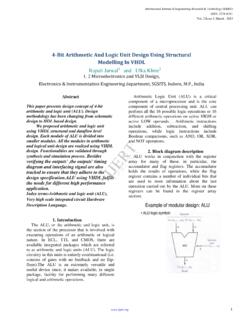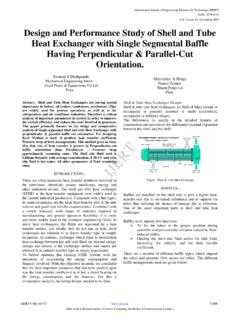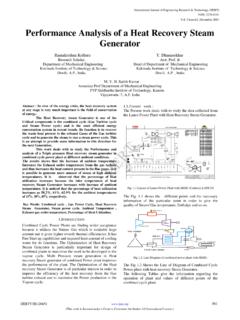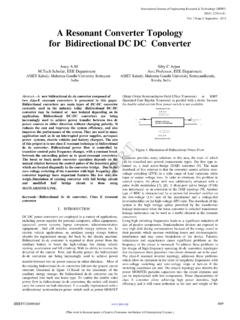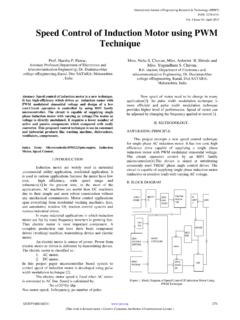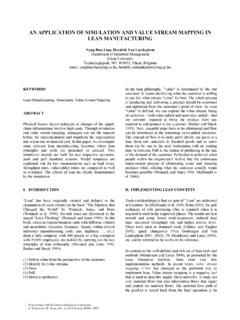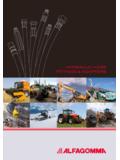Transcription of Value And Non- Value Added (VA / NVA) Activities …
1 Value And Non- Value Added (VA / NVA) Activities Analysis Of A Inspection Process A Case Study 1 * , 2 1 Research scholar, 2 Professor Department of Mechanical Engineering PSG College of Technology, Coimbatore 641 004, India Abstract This case study presents an application of lean concept in term of Value and non- Value Added analysis for inspection process of a manufacturing industry. The process involves moving the part from manufacturing cell to inspection cell for inspection Activities and again to manufacturing cell for further operation. The process was observed and split into Activities . The Activities were classified into Value Added (VA), non- Value Added (NVA) and essential non- Value Added (ENVA) Activities .
2 By categorization and VA / NVA analysis by Cross Functional Team (CFT), most of the NVAs have been eliminated by shifting the Inspection to Production cell. After elimination of NVAs, the total times of inspection is reduced by 30 % and NVA is reduced by 77%. Key words : Lean Tools, Value Added activity, Non- Value Added activity, Essential non- Value Added activity 1. Introduction In today s global and highly competitive environment, it is essential for the survival of any firm to be adaptive, price competitive, responsive, proactive and has the capability to deliver world class products according to diverse customer requirements. These challenges force companies to implement various Lean tools to meet the needs of the ever-changing market demand by eliminating wastes associated with manufacturing Value stream.
3 To be a world-class organization and to be stable in the global market, the firm does not have to operate worldwide or even nationwide. It may be a small local organization, which leads in its area / fields embraces and actively demonstrates to the characteristics of world-class performance. World-class performance maintains, continued success through the development of an organizational environment that is distinctly different from peer and competitor firms in its philosophy and wealth-creating formula. Lean production is one of the initiatives that many major businesses all around the world have been trying to adopt in order to remain competitive in the increasingly global market (Schonbergerm, 2007; Womack et al.)
4 , 1990). The core thrust of lean production is the capability of working synergistically to create a high-quality system that produces finished products at the pace of customer demand with little or no waste (Shah and Ward, 2003). International Journal of Engineering Research & Technology (IJERT)Vol. 2 Issue 2, February- 2013 ISSN: The focus of this multi-dimensional approach is on cost reduction by eliminating non- Value - Added Activities and using tools such as Just in Time (JIT), Cellular manufacturing, Total Productive Maintenance, and setup reduction to eliminate waste (Abdulmalek and Rajgopal, 2007; Monden, 1998; Nahmias, 2001) not only within the organization but also along the company s supply chain network (Scherrer-Rathje et al.
5 , 2009). The core thrust of lean production is that the mentioned tools can work synergistically to create a streamlined high-quality system that produces finished products at the pace of customer demand with little or no waste (Shah and Ward, 2003). 2. VA / NVA Activities Jeffrey Linker stated that lean is a principle of production manufacturing by reducing process time and eliminating all wastes for adding more Value Added into the whole process. The most effective way to reduce costs while keeping up with the competition is to become "Lean" by reducing or eliminating waste. Womack and Jones define waste as any activity that does not add Value to the product as defined by the customer.
6 In Lean perspective, every activity is categorized as either a Value Added (VA) or Non- Value Added (NVA) activity. However, it should be noted that even some perceived NVA Activities which may be necessary to comply with certain requirements. Such Activities are termed as Essential Non- Value Added (ENVA) Activities . Figure 1 illustrates the various categories of Activities . Figure 1 : categorization of Activities 3. Case Study This case study aims to apply the lean concept in term of Value and non- Value Added analysis to the inspection process of a Bracket manufacturing module. The bracket manufacturing process consists of Operation 1 and operation 2 (each side). After completion of Operation 1, the part is moved from Production cell to NDT inspection cell.
7 After completion of Inspection, the part is again moved to production cell for Operation 2. Then the part is sent to inspection cell for NDT inspection, dimensional inspection and visual inspection. After completion of final inspection, the part status is updated in the system. International Journal of Engineering Research & Technology (IJERT)Vol. 2 Issue 2, February- 2013 ISSN: Activity Disaggregation and Analysis The Activities of the Inspection process have been disaggregated into elements and the cycle time / Lead time is studied. Each activity is analyzed and categorized into Value Added (VA), Non- Value Added (NVA) and Essential Value Added (ENVA) Activities .
8 Based on the brainstorming session conducted by the researcher with Cross Functional Team (CFT), it decided to shift the NDT inspection to production cell and the action plan is updated (Figure 2). After improvement, the part after completion of Operation 1 is subjected to NDT inspection in the production cell itself and taken for Operation 2. Then NDT inspection is carried out for other side. Finally, the part is moved to inspection cell for final and visual inspection (Figure 3). Figure 2: VA / NVA status before improvement International Journal of Engineering Research & Technology (IJERT)Vol. 2 Issue 2, February- 2013 ISSN: Figure 3: VA / NVA status after improvement Figure 4: VA / NVA / ENVA status before & after improvement 4.
9 Results and Discussions: Based on the analysis done, some of the Activities are Value Added and some are not. Some of the supporting Activities such as preparing equipment, part, report, cleaning and system updation are considered as Essential non- Value Added Activities which are necessary for the process. Non- Value International Journal of Engineering Research & Technology (IJERT)Vol. 2 Issue 2, February- 2013 ISSN: Added Activities should be taken into a consideration elimination or time reduction. Most of the non- Value Added Activities are waste and referring to Figure 3, some of the NVA Activities still remain, are needed such as sending the part after NDT inspection subsequent to Operation 2.
10 Shifting the Inspection to Production cell resulted in elimination of most of the NVA Activities by elimination of unnecessary transportation and movement of part. The total inspection time is reduced from 349 min to 244 min (reduction by 30%) and the NVA is reduced from 137 min to 32 min (reduction by 77 %). 5. Conclusions The case study has achieved its objective through VA / NVA analysis carried out in a inspection process of a production module to eliminate NVA Activities . By brainstorming and analysis, after shifting the inspection process to the production module, the transportation waste has been drastically reduced. The total inspection has been reduced by 30% by reducing the NVA Activities time by 77%.
